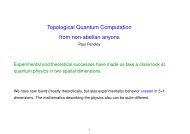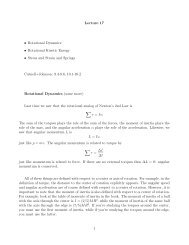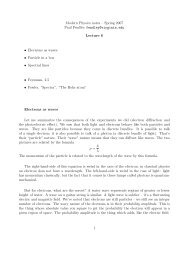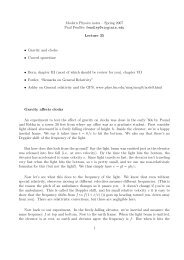Angular momentum and positronium decay - Paul Fendley
Angular momentum and positronium decay - Paul Fendley
Angular momentum and positronium decay - Paul Fendley
Create successful ePaper yourself
Turn your PDF publications into a flip-book with our unique Google optimized e-Paper software.
we do special relativity, we’ll see how one can underst<strong>and</strong> energy conservation in such <strong>decay</strong>s<br />
(advance preview: E = mc 2 ).<br />
Positronium is sort of like hydrogen, with the positron playing the role of the proton. But<br />
as opposed to hydrogen, the positron is not stable: after about 10 −10 seconds, the positron<br />
<strong>and</strong> electron annihilate into photons. Thus we say that <strong>positronium</strong> <strong>decay</strong>s, like a radioactive<br />
nucleus.<br />
But now here’s the interesting part. Let’s look at the spin of <strong>positronium</strong>. The electron <strong>and</strong><br />
positron each can have S z = /2 or S z = −/2. There are therefore four possible states for the<br />
spins of an electron <strong>and</strong> a positron:<br />
| ↑↑〉, | ↑↓〉, | ↓↑〉, | ↓↓〉<br />
Remember that although we can not in general know all the components of the spin at one time,<br />
we can know both S z <strong>and</strong> ⃗ S · ⃗S. To get the total S z , you just add the S z of each. The four<br />
possible spin states of <strong>positronium</strong> therefore have S z = , 0, 0, <strong>and</strong> − respectively.<br />
Finding ⃗ S · ⃗S for <strong>positronium</strong> is trickier. Remember that a particle is of spin-s when ⃗ S · ⃗S =<br />
s(s + 1) 2 . For example, for a spin-1/2 particle, ⃗ S · ⃗ S = 3 2 /4: this is easy to check by<br />
remembering that always S x = ±/2, S y = ±/2 <strong>and</strong> S z = ±/2. This means that always<br />
(S x ) 2 = 2 /4, (S y ) 2 = 2 /4 <strong>and</strong> (S z ) 2 = 2 /4, so that ⃗ S · ⃗S = 3 2 /4 as claimed. For general spin<br />
s, S z can have the quantized values<br />
S z = −s, (−s + 1), . . . , (s − 1), s<br />
This means there are (2s + 1) possible spin states of a spin-s particle.<br />
There are four possible spin states of <strong>positronium</strong>. Thus you might guess that <strong>positronium</strong><br />
is of spin 3/2. However, this can’t be: the four possible S z values of a spin 3/2 particle are<br />
−3/2, −/2, /2, 3/2, while the four S z values of <strong>positronium</strong> are S z = −, 0, 0, . Thus<br />
what happens is that there are two possible spin values for <strong>positronium</strong>. A <strong>positronium</strong> particle<br />
can either have spin 1 (<strong>and</strong> so S z = , 0, −) or spin 0 (<strong>and</strong> so S z = 0). This is possible because<br />
<strong>positronium</strong> is a bound state of fundamental particles.<br />
This explanation leaves one question still open. Of the two states with S z = 0, which has<br />
⃗S · ⃗S = 0, <strong>and</strong> which has ⃗ S · ⃗S = 2 2 ? On your homework, you’ll check that the state<br />
is the one with ⃗ S ⃗ S = 0.<br />
1<br />
√ | ↑↓〉 − √ 1 | ↓↑〉<br />
2 2<br />
We need to know one more thing about spin before underst<strong>and</strong>ing <strong>positronium</strong> <strong>decay</strong>. Photons<br />
have spin 1. Let the z axis be the direction the photons is moving (remember light is never<br />
2











